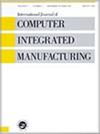(DT4Smart)一种基于数字孪生的智能仓库模块化设计方法
IF 3.7
3区 工程技术
Q2 COMPUTER SCIENCE, INTERDISCIPLINARY APPLICATIONS
International Journal of Computer Integrated Manufacturing
Pub Date : 2023-11-05
DOI:10.1080/0951192x.2023.2278100
引用次数: 0
摘要
摘要随着新一代信息技术的迅速兴起和广泛采用,人们越来越认识到数字化仓库设计的必要性。然而,在虚拟环境中创建物理仓库的数字副本是一项复杂的任务。本研究介绍了一个基于数字孪生的智能仓库设计框架,包括四个关键步骤:(1)定义数字孪生的维度;(2)建立一个包含物理仓库、数字孪生和设计过程的数字孪生框架;(3)实现数字孪生的模块化技术;(4)基于数字孪生的智能仓库运营。为了验证所提出的框架,我们提出了一个涉及半导体制造工厂的详细案例研究。结果证明了基于数字孪生的智能仓库设计及其操作流程的有效性。关键词:数字孪生智能仓库设计框架致谢作者感谢编辑和匿名审稿人提供的宝贵意见。作者披露了对本文的研究、创作和/或出版的以下财政支持。江苏省社科基金(批准号:2022sjyb0183)、江苏省高层次创新创业人才引进计划(批准号:2022sjyb0183)资助。JSSCB20210481),南京信息工程大学启动研究基金,新加坡A*STAR IAF-PP基金(批准号:JSSCB20210481)。A1895a0033),隶属于“下一代仓库的数字孪生”项目。披露声明作者未报告潜在的利益冲突。数据可用性声明作者确认在文章中可以获得支持本研究结果的数据。本研究由江苏省高层次创新创业人才引进计划[JSSCB20210481]资助;新加坡A*STAR基金[A1895a0033];南京信息工程大学启动科研基金。本文章由计算机程序翻译,如有差异,请以英文原文为准。
(DT4Smart) a digital twin-based modularized design approach for smart warehouses
ABSTRACTThe rapid emergence and widespread adoption of next-generation information technologies have led to a growing recognition of the need for digitalized warehouse designs. However, creating a digital replica of a physical warehouse in a virtual environment is a complex task. This research introduces a framework for designing smart warehouses based on digital twins, consisting of four key steps: (1) defining the dimensions of the digital twin, (2) establishing a digital twin framework that encompasses the physical warehouse, digital twin, and design processes, (3) implementing modularization techniques for the digital twin, and (4) operating the smart warehouse based on the digital twin. To validate the proposed framework, we present a detailed case study involving a semiconductor manufacturing plant. The results demonstrate the effectiveness of the digital twin-based smart warehouse design and its operational processes.KEYWORDS: Digital twinsmart warehousewarehouse designframework AcknowledgmentsThe authors thank the editor and the anonymous reviewers for their helpful comments. The authors disclose receipt of the following financial support for the research, authorship, and/or publication of this article. This work was supported by Jiangsu Social Science Fund of China (Grant No.2022SJYB0183), Introduction Program of High-Level Innovation and Entrepreneurship Talents in Jiangsu Province (Grant No. JSSCB20210481), Starting Research Fund from the Nanjing University of Information Science & Technology, and Singapore A*STAR IAF-PP fund (Grant No. A1895a0033) under the project “Digital Twin for Next Generation Warehouse”.Disclosure statementNo potential conflict of interest was reported by the author(s).Data availability statementThe authors confirm that the data supporting the findings of this study are available within the article.Additional informationFundingThe work was supported by the Introduction Program of High-Level Innovation and Entrepreneurship Talents in Jiangsu Province [JSSCB20210481]; Singapore A*STAR IAF-PP fund [A1895a0033]; Starting Research Fund from the Nanjing University of Information Science & Technology .
求助全文
通过发布文献求助,成功后即可免费获取论文全文。
去求助
来源期刊
CiteScore
9.00
自引率
9.80%
发文量
73
审稿时长
10 months
期刊介绍:
International Journal of Computer Integrated Manufacturing (IJCIM) reports new research in theory and applications of computer integrated manufacturing. The scope spans mechanical and manufacturing engineering, software and computer engineering as well as automation and control engineering with a particular focus on today’s data driven manufacturing. Terms such as industry 4.0, intelligent manufacturing, digital manufacturing and cyber-physical manufacturing systems are now used to identify the area of knowledge that IJCIM has supported and shaped in its history of more than 30 years.
IJCIM continues to grow and has become a key forum for academics and industrial researchers to exchange information and ideas. In response to this interest, IJCIM is now published monthly, enabling the editors to target topical special issues; topics as diverse as digital twins, transdisciplinary engineering, cloud manufacturing, deep learning for manufacturing, service-oriented architectures, dematerialized manufacturing systems, wireless manufacturing and digital enterprise technologies to name a few.

 求助内容:
求助内容: 应助结果提醒方式:
应助结果提醒方式:


